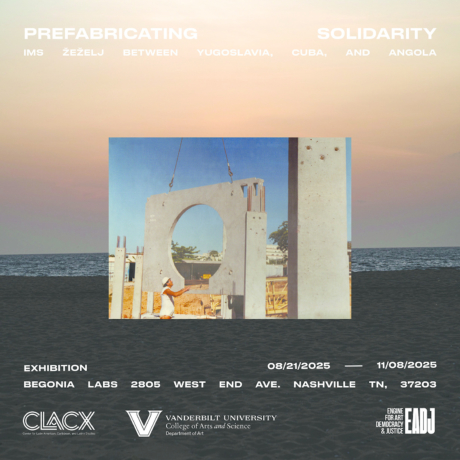
Exhibitions
PREFABRICATING SOLIDARITY: IMS-ŽEŽELJ BETWEEN YUGOSLAVIA, CUBA, AND ANGOLA
Begonia Labs (Vanderbilt University) / 2805 West End Ave. August 21, 2025 - November 8, 2025
Prefabricating Solidarity was conceived and organized by a collaborative curatorial and authorial team, including:
Vladimir Kulić
Vesna Pavlović
Jelica Jovanović
Fredo Rivera
Ana Knežević
Emilia Epštajn
Exhibition and Graphic Design by Antun Sevšek and Damir Gamulin. The technical implementation by Ivan Vukdragović (Belgrade) and Taylor Raboin (Nashville).
In the 1970s, Yugoslavia, Cuba, and Angola were connected through an unusual circulation of prefabricated building technology. As members of the Non-Aligned Movement seeking development paths outside the Cold War binary, their geopolitical alignment acquired physical dimension through the IMS Žeželj system—a sophisticated skeletal structure of concrete columns and floor slabs held together by steel cables, developed in 1957 by engineer Branko Žeželj at Belgrade's IMS Institute.
The circulation of IMS technology among Yugoslavia, Cuba, and Angola reorganized this colonial "geometry of power." Rather than following the traditional unidirectional flows from imperial centers to peripheries, these exchanges created an entangled triangle of technological solidarity. The system wasn't simply exported but co-produced, with engineers adapting it to local conditions and needs. Through these transformations, a technology with colonial origins became a tool for post-colonial development.
Between 2023 and 2024, the research team traveled to Cuba and Angola to document these buildings and interview participants in these exchanges. Through photographs, archival materials, and video interviews with architects and engineers from all three countries, this exhibition explores how "triangular solidarity" created lasting connections across continents. Though the ambitious vision of an alternative world order would ultimately falter in the 1990s, the concrete structures endure, housing thousands of families and standing as testament to a moment when technological exchange could serve liberation rather than domination.

